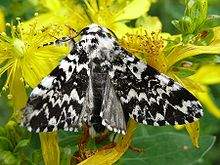Monastery woman (butterfly)
| Nun | ||||||||||||
|---|---|---|---|---|---|---|---|---|---|---|---|---|

Monastery woman ( Panthea coenobita ) |
||||||||||||
| Systematics | ||||||||||||
|
||||||||||||
| Scientific name | ||||||||||||
| Panthea coenobita | ||||||||||||
| ( Esper , 1785) |
The monastery woman ( Panthea coenobita ), also called high forest spruce owl or monk , is a butterfly ( moth ) from the subfamily of the Pantheinae within the owl butterflies (Noctuidae).
features
The monastery woman is a medium-sized butterfly with a wingspan of 41 to 48 millimeters. The head and thorax are colored white with irregularly distributed black spots. The fore wings are white in the basic color with irregularly distributed black spots and lines. The basic white color dominates in the basal and subterminal fields. Median lines, the subterminal field and the area with the flaws towards the costal edge have a white border. The outer wavy line is strongly toothed. The kidney flaw is bordered white and black. The blemish is white with a black spot. The fringes of the fore and hind wings are colored alternately white and black. The hind wings are blackish gray with irregularly distributed black areas. The discal spot and the outer transverse line are also drawn in black. The drawing of the top of the wings essentially corresponds to the drawing on the bottom. However, the front wing has fewer white areas overall, while the underside of the hind wing has more white areas overall.
The egg is strongly flattened at the base, the surface has numerous, somewhat irregular longitudinal ribs, which, however, do not reach the micropyl region. It is light yellow at first and later turns reddish yellow.
The egg caterpillar is light brown in color with a black head. Later stages are usually from a dark brown to black-brown basic color. There are also white, transverse spots on the back and brown vertical stripes on the sides. In the later stages the caterpillar is very hairy, with tufts of hair that protrude like a collar.
The doll is rather short and fat. It is glossy red-brown to black-brown in color. The Kremaster is short and conical in shape with three longer and several very short, curved bristles.
Similar species
There is a certain similarity in the drawing to the nun ( Lymantria monacha ), whose males, however, have very strongly combed antennae. In addition, the females are much larger and have a reddish abdomen.
Geographical distribution and habitat
The species occurs from Eastern France, the Benelux countries, Central Europe, across Belarus, Ukraine and Central Russia, Siberia to the Far East (Amur region, northern China, Japan, Korea). In the north, the occurrence extends into southern Fennoscandia, in the south to northern Italy and the Balkan Peninsula (mostly isolated occurrences here) and Asia Minor. With the exception of a few isolated occurrences in northern Greece, the species is absent in the Mediterranean areas, and the species is also absent in the British Isles. An isolated occurrence is known from the central Pyrenees.
The nun prefers to live in coniferous forests.
Way of life
The nun flies from mid-May to early August in one generation, rarely in a second generation. The eggs are laid directly on the needles of the host plants in small groups of around 10 to 20 pieces. The caterpillars feed on the needles of Scots pine ( Pinus sylvestris ), Swiss stone pine ( Pinus cembra ) and Korean pine ( Pinus koraiensis ) as well as the species of the genera larch ( Larix ), spruce ( Picea ) and fir ( Abies ). They can be found from August to October. They pupate in autumn on or in the ground at the foot of tree trunks, where the pupae also overwinter. The doll can also linger for two years.
Danger
The nun is only considered to be threatened with extinction in the city-state of Hamburg, in Saxony-Anhalt she is endangered. In contrast, the stocks in Germany as a whole and in the other federal states are not endangered.
Systematics
The populations in the Far East were formerly known as their own subspecies Panthea coenobita ussuriensis Warnecke, 1917. Fibiger et al. (2009) reunited them with the nominate subspecies. They do not recognize any subspecies.
swell
Individual evidence
literature
- Michael Fibiger, László Ronkay, Axel Steiner & Alberto Zilli: Noctuidae Europaeae Volume 11 Pantheinae, Dilobinae, Acronictinae, Eustrotiinae, Nolinae, Bagisarinae, Acontiinae, Metoponiinae, Heliothinae and Bryophilinae. 504 pp., Entomological Press, Sorø 2009 ISBN 978-87-89430-14-0
- Manfred Koch : We determine butterflies. Volume 3: Owls. 2nd, expanded edition. Neumann, Leipzig / Radebeul 1972, DNB 760072930 .
- Walter Forster , Theodor A. Wohlfahrt : The butterflies of Central Europe. Volume 4: Owls. (Noctuidae). Franckh'sche Verlagshandlung, Stuttgart 1971, ISBN 3-440-03752-5 .


